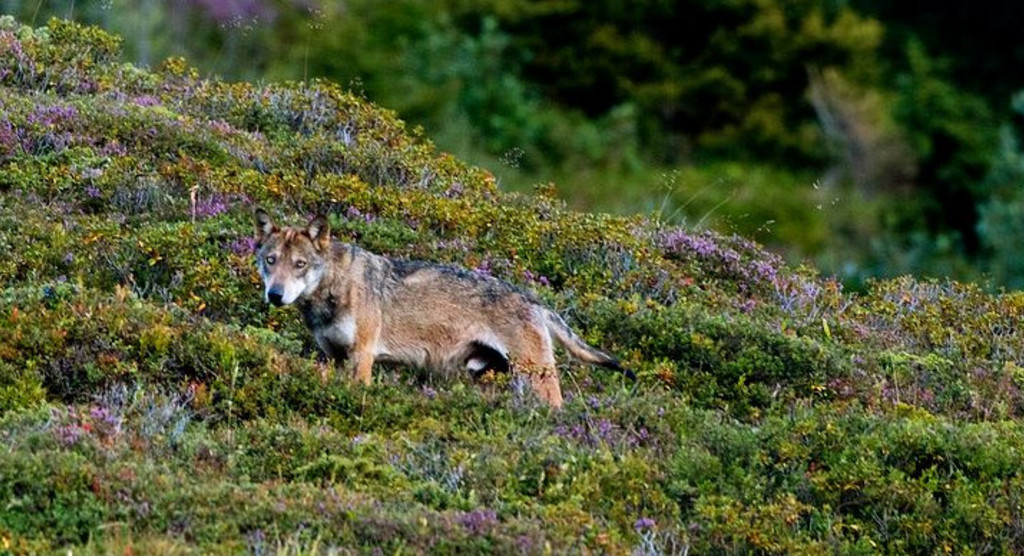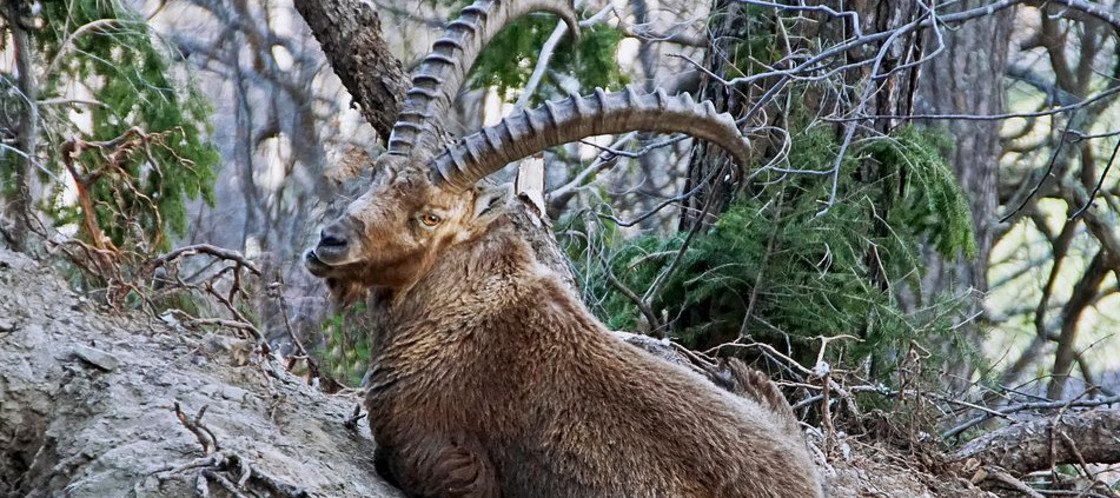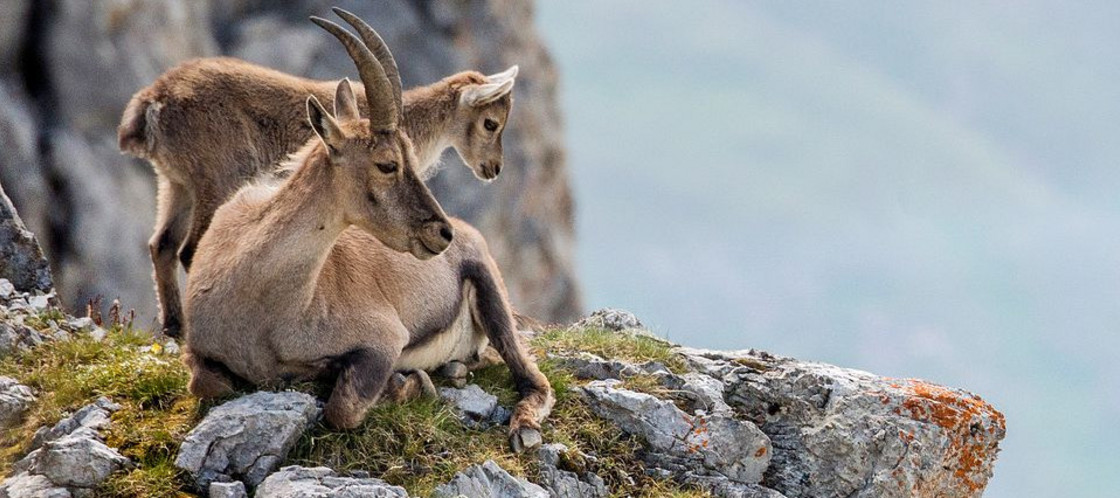
The wolf is here to stay
How does the story with the wolf go?


The Alpine ibex is an imposing, iconic creature. Yet the “mountain king” almost disappeared from Switzerland for good. Poachers smuggled young ibexes back into the Swiss Alps before the animal was officially reintroduced 100 years ago. Resettling any endangered species is a very complicated business.
Stockhorn mountain in the Bernese Oberland rises 2,190 metres above sea level – the highest elevation for miles around and a magnet for hikers, climbers, paragliders and snowshoe enthusiasts. If former managing director of the Stockhorn cableway Alfred Schwarz has anything to do with it, the Stockhorn massif will soon also be home to the Alpine ibex. The Freunde des Stockhorns (Friends of the Stockhorn) association and the canton of Berne hunting inspectorate are planning to reintroduce the mighty mammal.
«We want to return the ibex to its old habitat»former managing director of the Stockhorn cableway
Ibexes were indeed roaming the Stockhorn massif 200 years ago. From the Middle Ages, these elegant and hardy extreme climbers were popularised as the embodiment of rude health. The ibex was an admired, much sought-after animal, whose every body part (almost) was said to have medicinal powers. Ibex remedies were once all the rage. Yet ibexes were also killed for their meat. Hunting them became a lucrative business.

Intensive hunting and extensive deforestation made life difficult for the “mountain king”, as did the proliferation of pastures at increasingly high altitudes. So much so that the animal disappeared from the Swiss Alps altogether. Its fate sounds strangely familiar. The last Swiss ibex was shot in Valais in 1804. A handful of surviving ibexes took refuge over the border in northern Italy, subsequently enjoying protection from the then King of Italy, Victor Emmanuel II, whose gamekeepers carried out their duty with vigour.
Meanwhile, it took grassroots action to champion the animal’s cause in Switzerland. The Swiss Hunting Act of 1875 laid the ground for the reintroduction of the ibex, yet politicians did little to follow up with concrete measures. Private initiatives ultimately got the ball rolling instead – first in the canton of St. Gallen, then shortly after in the canton of Grisons.
Ironically, the same poachers who had wiped out ibexes now played an important role in re-establishing them – smuggling young animals from Italy into Switzerland on behalf of a hotelier.
«One ibex was worth up to 1,000 francs, which is equivalent to the cost of a mid-range car in today’s money.»
Spokesman of the Swiss National Park in the canton of Grisons.
But what was the motivation behind reintroducing the animal into Switzerland? Lozza believes that emotional factors were key. “People wanted to make amends for what had happened.” Tourism also played a part, “particularly in the canton of Grisons, whose coat of arms bears an ibex,” he says. Conservation was less of an issue. “Environmentalism hadn’t really taken off in those days.”
Around 300 ibexes now live in the Swiss National Park. However, ibex numbers have also grown steadily elsewhere in less-protected areas ever since the first reintroduction measures began in 1920. Last year, some 18,500 ibexes were counted around Switzerland, spread over various colonies in the Alpine cantons.
The ibex is one of several animal species that were wiped out in Switzerland and have returned in recent decades, either of their own accord or through human assistance. Wolves and sporadically sighted bears are the best-known and most controversial returnees. Both simply wandered back into Switzerland. However, beavers and lynxes – like ibexes – were proactively resettled. Whereas the ibex found its way back into Switzerland illegally at first, the beaver and lynx owe their reappearance to the work of conservationists and their political lobby. Provisions governing the reintroduction and resettlement of once-extinct animals are now legally enshrined.

Despite legislation, arguments flare up practically every time any species is transplanted back into Switzerland. And the fundamental question never changes: how many of these animals can be resettled without causing major problems such as crop damage or livestock losses? The law stipulates which animals can be controlled and when. Yet public feeling regularly runs high regardless, either when animals cause harm or damage, or when animals are shot because of the very problems they cause. The revised Hunting Act, rejected by voters on 27 September 2020, was the latest chapter in this perennial and emotional saga. It was mainly wolves that were caught in the pre-referendum crossfire.
Taking into account such sensitivities, the reintroduction project on the Stockhorn massif has already involved in-depth consultation with farmers and pasture owners.
«They told us that they are worried about ibexes depriving their livestock of food and potentially transmitting diseases.»
Former Managing Director of the Stockhorn cableway
Reinhard Schnidrig, the man at the Federal Office for the Environment with overall responsibility for wildlife conservation, is currently assessing the Stockhorn project application. Schnidrig says that the reintroduction of the ibex into Switzerland has basically been a success. But he also believes that big challenges lie ahead over the next 100 years: “Unregulated hunting used to be the problem. Now it is our intensive use of Alpine areas.” Due to the boom in outdoor sports, the ibex and other wild animals now compete with mountain lovers for space, he explains. Interest in the Alpine environment is a good thing, but this should not be to the detriment of wild animals. “Before we reintroduce animals, we always need to think about how we manage the situation on the ground,” he says.
Climate change is another issue. Higher temperatures are driving the ibex further up the mountains. In the Swiss National Park; females and their offspring now live at altitudes that are 120 metres higher on average than they were 25 years ago. This brings them closer and closer to the summer grazing areas of the males. “Over the long term, this could lead to greater competition for food within the species,” says Lozza.
Yet outside influences are not the only challenge facing the Alpine ibex. A lack of genetic diversity is another Achilles heel. Essentially, Switzerland’s ibexes are descendants of the animals that were originally smuggled from Italy; their gene pool is still very small. These genetic limitations probably explain why some ibex colonies are no longer growing as strongly as they once were. Inbreeding also means that they are more susceptible to diseases. Schnidrig therefore believes that inserting both Swiss and foreign ibexes into new colonies is an option worth considering.
It remains to be seen whether foreign ibexes will be scrambling around the slopes of the Stockhorn massif one day. First, the project is hoping to get the green light from Berne. The aim is to start introducing the first animals as early as spring 2021.
Comments
Comments :
Merci pour ce reportage très intéressant. Nous possédons un chalet dans le Val de Bagne et lorsque nous pouvons arriver au printemps , pas comme cette année, nous voyons paître de nombreux bouquetins sur notre terrain. Ils semblent tous en bonne santé ainsi que les troupeaux que nous voyons plus haut. Un vrais bonheur de pouvoir regarder vivre ces animaux magnifique qui nous laissent approcher jusqu'à 50 mètres.